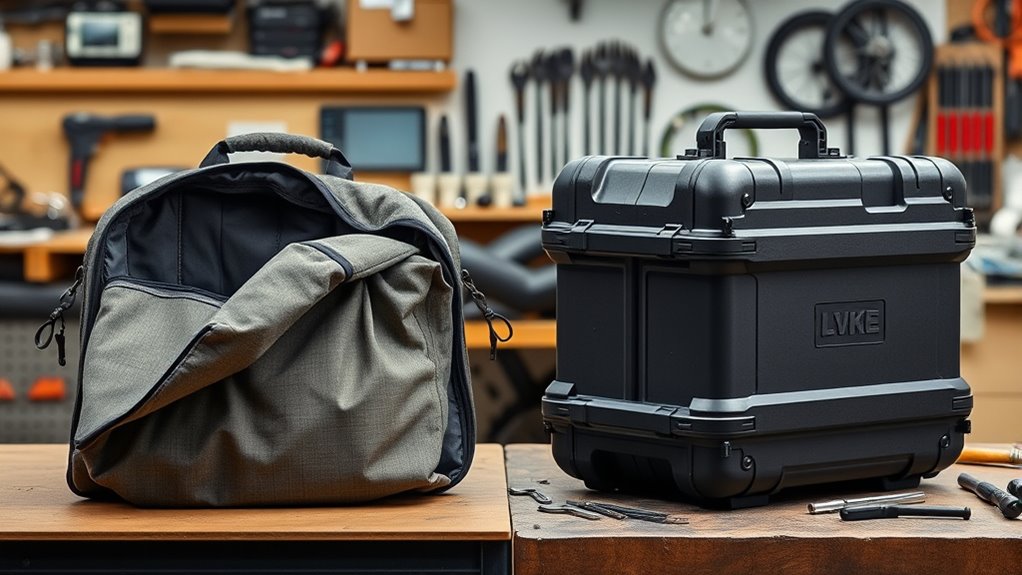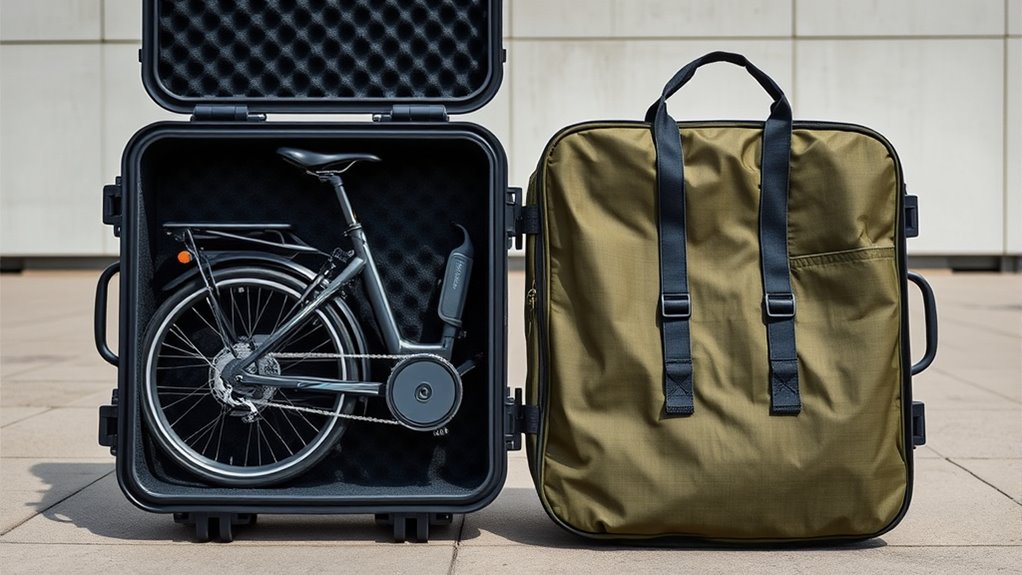Building your own soft or hard case for a folding e-bike lets you customize protection that fits your needs and budget. Soft cases use weather-resistant fabrics with foam padding and easy access features, while hard cases are made from durable shells with foam inserts for maximum impact resistance. Incorporate lock points and reinforced handles for security and portability. If you want to explore design tips and materials to craft your perfect case, you’ll find useful ideas ahead.
Key Takeaways
- Choose weather-resistant fabrics and durable shells like polypropylene or aluminum for protection and longevity.
- Incorporate foam padding or custom foam inserts to secure the battery and absorb impacts.
- Add reinforced handles, wheels, or straps for easier transport and handling of the case.
- Include lock mounting points and tamper-resistant features to enhance security against theft.
- Design for quick access with zippers or straps, allowing easy battery removal, charging, and maintenance.

Creating your own e-bike case can be a rewarding project that saves you money and guarantees a perfect fit for your bike. Whether you choose to build a soft-case or a hard-case, crafting a custom container allows you to tailor the design to your specific needs. It’s vital to take into account bike lock security when designing your case, ensuring your bike remains protected from theft. Incorporate lock mounting points or reinforced areas that accommodate bike locks, making it difficult for thieves to tamper with or remove your bike without proper authorization. This added layer of security is critical, especially if you plan to leave your e-bike in public spaces often.
Battery protection methods are equally important when creating your own case. Your e-bike’s battery is a valuable component that needs safeguarding from impacts, moisture, and temperature extremes. In a soft-case design, you might use high-density foam padding or specialized shock-absorbing materials around the battery compartment to cushion against bumps. For a hard-case, consider adding internal foam inserts or custom-cut compartments that snugly fit the battery, preventing movement during transport. Ventilation also plays a role; ensure your case design includes vents or airflow channels to prevent overheating during extended rides or storage. Using weather-resistant materials for your case helps keep the battery dry and protected from rain or humidity, which can damage the electronics. Additionally, understanding the efficiency ratings of materials and components can help you select the most effective options for insulation and protection.
When building your case, think about ease of access as well. Incorporate quick-release straps or zippers that allow you to remove the battery easily for charging or maintenance. Reinforced handles or wheels can make transporting your case more manageable, especially if it’s bulky or heavy. For soft-cases, waterproof fabrics with strong stitching work well to resist wear and tear, while hard-cases benefit from durable shells like polypropylene or aluminum. Remember that the design should balance portability with the ability to secure your bike effectively. Locking mechanisms integrated into the case, such as padlock points or integrated locking zippers, further enhance bike lock security, giving you peace of mind when leaving your e-bike unattended.
Frequently Asked Questions
How Do I Ensure the Case Won’T Damage My Bike During Transport?
To prevent damage during transport, you should add padding protection around your bike, especially at delicate points like the frame and components. Make sure the case has secure fastening straps or latches to keep the bike stable and prevent movement. Also, choose a case with reinforced sides and padding, and double-check all closures before shipping. This combo guarantees your bike stays protected and secure throughout the journey.
What Materials Are Best for DIY E-Bike Case Durability?
For DIY e-bike cases, choose materials with high impact resistance like tough plastics such as polyethylene or polypropylene, or durable fabrics like Cordura nylon. These materials absorb shocks better, protecting your bike during transport. Incorporate reinforced corners and padding to enhance impact resistance further. Using sturdy, lightweight materials guarantees your case is durable yet manageable, giving your e-bike the protection it needs without adding unnecessary weight.
Can I Customize My Case for Specific E-Bike Models?
Yes, you can customize your case for specific e-bike models. Focus on adding case padding to protect your bike and designing custom fittings that securely hold its unique frame shape. Measure your e-bike carefully to guarantee a snug fit, and adjust padding and fittings accordingly. This way, you get a tailored case that offers ideal protection, making transport safer and more convenient for your specific e-bike.
How Do I Balance Weight and Protection in My DIY Case?
You should focus on even weight distribution by placing heavier parts at the bottom and center of your case. Use padding techniques like foam or bubble wrap to cushion delicate components and prevent shifting during transit. This balance ensures your e-bike stays protected without adding unnecessary weight. Regularly check and adjust the padding to maintain ideal protection and ease of handling, making your DIY case both lightweight and secure.
Are There Safety Standards My DIY Case Should Meet?
A stitch in time saves nine, so yes, your DIY case should meet safety standards for bike security and durability. Look for relevant certifications like ASTM or EN standards to guarantee it withstands impacts and protects your e-bike. Also, consider case aesthetics to keep it visually appealing. Meeting these standards helps prevent accidents, keeps your bike secure, and ensures your DIY project is both safe and stylish.
Conclusion
Now that you’ve explored DIY soft and hard cases for your folding e-bike, you’re like a skilled tailor crafting a custom suit. Whether you choose a flexible soft case or a sturdy hard shell, you’re shaping a protective cocoon that keeps your e-bike safe on every adventure. With your hands and ingenuity, you’re transforming everyday materials into a reliable fortress—ready to roll anywhere life takes you. Ride confidently, knowing your e-bike is well-guarded by your own craft.









